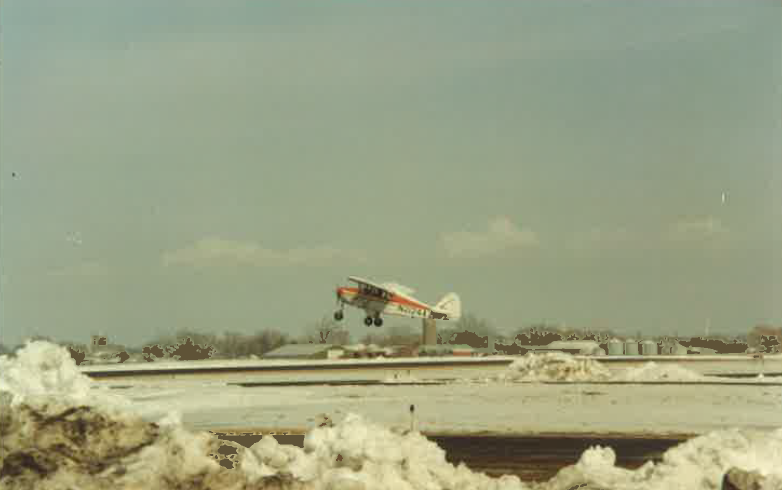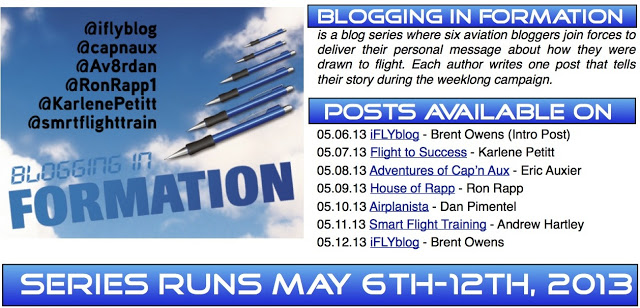I hope you’ve been following along this week while my blogger/pilot compatriots have been telling their stories about how and why they started flying during the first (hopefully of many) “Blogging in Formation” series. If you are coming upon this post in the future, or have not seen the posts from the four illustrious bloggers & pilots before me, here are links to their posts:
- Karlene Petitt: What Drew Me to Flying
- Eric Auxier: How I was Brought to Flying
- Ron Rapp: Looking Back: How I got Started in Aviation
- Dan Pimental: How I was Brought into Flying? Blame it on the Darts
Do yourself a favor and read these posts as well, and don’t forget to tune in tomorrow when the brains of the operation – or at least the man behind the curtain (who thought up the idea in the first place), Brent Owens, makes his post – the final of the series: http://iflyblog.com/2013/05/12/my-journey-to-flight/
So how and why did I get into flying?
My story is the archetypal story of the son whose father was a pilot, so he grew up to be a pilot as well. That said, it isn’t quite so simple.
My earliest memory – fuzzy as it may be – is sitting on my dad’s lap while he “let me fly” a Cessna 172 Skyhawk. I was four years old. I still have my dad’s logbook, below is a scan of the flight, in April of 1981:
A little more to the story: My dad was an Airframe & Powerplant mechanic who worked for Northwest Airlines. When I was just a baby, we moved from Ohio to Florida for my dad to go to school to get his A&P certificate. From there, we moved to Minnesota, then Wisconsin, then back to Ohio as my dad gained seniority and moved up to Crew Chief status.
While we lived in Wisconsin, Dad bought an old Piper Tri-Pacer (PA-22-135), N2124A (two-one-two-four-alpha), and fixed it up himself (a benefit of being a certified A&P is being able to save money and do the work yourself). I fondly remember taking rides in that airplane… going to East Troy airport in Wisconsin where the plane was tied down, climbing on (and jumping off) things at the airport, and even being the one to find the well-hidden start button under the pilot’s seat before the plane was even airworthy. I think I might have almost taken my dad’s head off that day in Wisconsin when the prop rotated. Still scares me to think about it.

When we lived in northern Ohio, I remember helping (at least I thought I was helping) re-cover the control surfaces of good old “two-four-alpha.” The elevator, rudder, and ailerons are still clear in my mind, hanging in our garage, the smell of the dope and the heat of the iron are fresh in my memory, though at the time I was only in fifth grade.
Now, my mom and younger brother were not fans of flying – at least not in “little” airplanes like the Tri-Pacer. Flying was something my dad and I did – and I took him up on it every time he offered. Until one day, when dad’s side of the family was visiting us and he was taking my uncles up with him – his brother and brother-in-law.
They decided that they wanted to go flying, and there was one seat available – a seat Dad naturally offered to me. A seat that I – unnaturally – did not take. Dad must have asked me three or four times if I was sure – and each time I declined. I still don’t know why.
That was the last flight of two-four-alpha; the plane struck improperly-marked telephone wires at the approach end of the runway at dusk and flipped upside-down in the grass before the runway, caught fire, and burned quickly (thanks to the flammable dope and fabric construction). Both my uncles and my dad escaped with their lives, but none came home that night. My uncles had scratches and compressed vertebrae and cuts and bruises, and my dad was badly burned. He ended up with third-degree burns on his right arm and leg, and had to have skin grafts. I don’t remember how long he was in the hospital, but I remember visiting while he was there. It was a pretty frightening time. A time I decided to stop liking aviation, since it nearly killed my dad.
But dad lived, and I even flew with him again – right back into the same airport where he crashed, in fact. And that lesson – one he never specifically taught me, but that I learned from his actions – is one that has stuck with me to this day: if you love something, it is always worth the risk. Minimize it, manage it, be aware of it; but you can’t give up something you enjoy just because it might kill you. Life is guaranteed to kill you anyway – so enjoy it by doing what you love, what you are passionate about, what your life would be empty for the lack of it. Fly.

My dad passed away two years or so after the crash. He had a massive heart attack due to a blood clot, probably latent and caused by his injuries from the crash. He was 45. I was not quite 14.
Needless to say, my mom was less than happy when I decided to pursue aviation as a career – I graduated from Eastern Michigan University in 2000 with a B.S. in Aviation Management. It was Mom, however, who re-sparked my passion for flight. The summer after my freshman year of college (I had not yet declared a major), my mom arranged for me to fly with her boss’s husband. He owned a homebuilt aircraft – I don’t even remember what kind – but as soon as the throttle went full for takeoff, I knew that my passion and love for aviation was still there. Or maybe my dad left that passion to me. Maybe it was a combination. No matter; I declared Aviation Management as my major the following year (EMU did not have a flight program at that time), joined AOPA, and have not looked back. I got my Private Pilot Certificate in 1999 at Ann Arbor airport.
I flew, a little, for fun, here and there, for a number of years. While working for a large business jet operator in central Ohio, I started my instrument rating, and finally finished it in 2008. I followed that up with my commercial certificate in late 2010 and my flight instructor certificate in early 2012. And here we are today.
My flying (like so many others’) has been rife with complications, stops, and starts – it wasn’t until I left the aviation industry to continue my career as a corporate trainer that I realized – again – that I can’t be happy without some aviation in my life.
My instrument training was initially done under 14 CFR Part 141 – meaning it is very structured and watched carefully by the Federal Aviation Administration (FAA). I took my checkride 62 days after graduating the instrument course. The FAA requires that it happen within 60 days for part 141. So I had to build 20-plus hours of cross-country time and retake the checkride under 14 CFR Part 61. That took about two years, due to frustration, time, and money – my wife and I had bought a house, I had just started a new job, blah, blah, blah.
But once I got that done, it was pretty steady. I worked out a leave of absence from the new job to complete my commercial certificate (including complex endorsement), and started working on my CFI certificate before leave ended. Between obtaining my commercial and my CFI certificates, my wife and I had our first child – a little girl. She’s now nearly two years old and is awesome. She’s quite possibly the only thing that overrides aviation in my world.
My next steps are to get my instrument instructor rating (CFII), multi-engine & multi-engine instructor (MEI), tailwheel (conventional gear), and seaplane. I really want to learn aerobatics, and I’ll probably learn to fly on skis as well, someday.
For right now, though, I absolutely love to instruct. If it paid better, it would be my full-time, all-the-time job. I’m hoping to supplement my flight instruction income with this blog (and the plans I have to expand it, including a podcast, e-ground school, and more – stay tuned), and when that starts happening, you’ll start seeing even more of me at the airport than you already do.
So I’ll leave off with this – I miss my dad every day, and I think of him each time I step into an airplane. And even though I miss him, thinking about him doesn’t make me sad at all. It makes me safe. See – I know that accidents can happen to anyone at any time, and I am always certain to do everything in my power to make sure that the risk I take each time I get in an airplane is minimal and mitigated as much as possible. And I try to pass that down to each and every one of my students – be they brand new and just starting training, or experienced, high-time professionals doing a flight review. And I also know that, no matter the risk, I’m going to keep flying.
You ask why I fly? Simple. There’s nothing else I could do.
Andrew Hartley is a certificated flight instructor in Columbus, Ohio, and the founder of Smart Flight Training.

